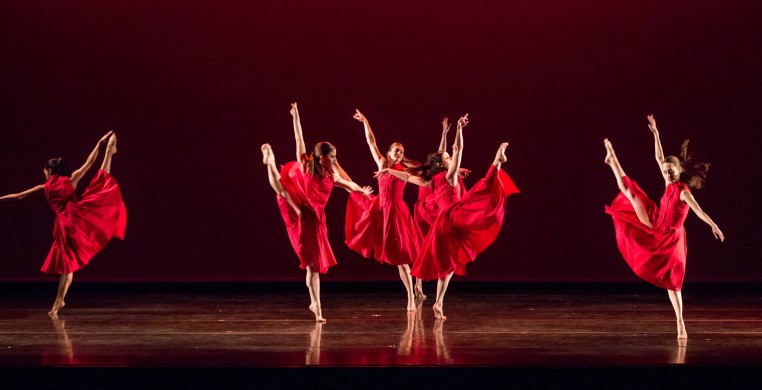“Chicago Revealed” corrals an eclectic collection of Chicago-centric choreography for Thodos Dance Chicago, presented last weekend at Skokie’s North Shore Center for the Performing Arts (to be repeated at Chicago’s Harris Theater for Music and Dance on March 5th).
The program, thoughtfully delineated as Act I and Act II, was divided by markedly contrasting tone. Artistic Director Melissa Thodos’s 30-minute narrative dance drama, “Sono’s Journey,” filled the entirety of Act I, while three separate abstractions formed Act II, with contemporary dance works by Thodos and two other Chicago choreographers inspired by various aspects of Chicago’s history, cultural fabric, and diverse communities. Chicago provides somewhat tenuous geographic common ground for the two halves, as Chicago plays a relatively incidental role in Japanese American ballerina Sono Osato’s story, while it is integral to the driving engine of all three works in the second half of the program.
My full appraisal of “Sono’s Journey” is lamentably diminished because, due to an aberration in communication about the curtain time, I arrived after the piece had already begun. I can confidently praise Thodos and her handsome company for delivering a heartfelt and engaging story, narrated by Ellen Karas’s moving voice-over excerpts from Osato’s memoir. Poignantly portrayed by Shelby Moran as Sono, “Sono’s Journey” is exactly what its title suggests, a kind of choreographic travelogue across the history of her life and career.
Thirteen distinct dance scenes illustrate the key events in Osato’s life in sequential episodes that utilize different dance genres to best reflect each--classical ballet, contemporary modern forms, tap, jazz, and Broadway show dancing. The remarkable event of her successful audition for the Ballet Russe on the stage of Chicago’s Auditorium Theatre at the age of fourteen, and her parents’ stewardship of the Japanese Gardens and Phoenix Pavilion in Chicago’s Jackson Park give Chicago bragging rights to only a small aspect of Osato’s story.
The larger story here, however, is her triumph over prevailing racial bias at a time when political correctness and diversity casting had yet to be invented. This aspect of her story is perhaps not as much in the forefront as one might have hoped, especially in light of Misty Copeland’s recent news-shattering achievement at American Ballet Theatre so many decades after Sono Osato’s tenure with the same company. We feel the impact most strongly when, during World War II, Osato is barred from touring abroad or to perform with Ballet Theatre in California, but it almost seems like an incidental side-bar to the rest of the storytelling.
The most compelling choreography that I viewed was Thodos’s departure from the classical idiom to a raw and emotionally immediate plunge into the chaos and horrors of war. Here, the whole company shone in visceral moves that brought the immediacy of Europe’s battlefield into the fabric of the story. In counterpoint, an equally moving love duet for Sono, and Sono as a young woman (Abby Ellison) and Victor (Brennan Renteria) set to Bach’s Double Violin Concerto in D Minor, lyrically captured the transcendent strength of their passion.
As polished and balletically competent as the dancers are, the rather literal representation of the Ballet Russe could not hold a candle to the real thing and lent a veneer of artificiality to an otherwise authentic use of interpretive movement that capitalized on the dancers’ strengths throughout the rest of the piece.
Kevin Iega Jeff’s “Redlines/Bluehorizon” (world premiere) is impressionistic and suggestive of interior conflict, reflected in Nathan Tomlinson’s stark, checkerboard lighting and the dancers’ upper body eruptions of loose squiggling vibrations, whole-body collapsing, and whipping arms along the floor. Set to the repetitive drone of music by Steve Reich and Hans Zimmer, life’s oppression loomed large in the various landscapes depicted by projected subtitles. Iega Jeff employs strong breath accents, clenched hands and stooping postures, arms thrust straight and darting, like spotlights in the darkness, and women falling backwards into men’s arms to evoke striking mood. The piece finishes in a mesmerizing tango sequence of couples moving upstage, leaving a lone female isolated from the community.
Robin Mineko Williams’ “At The Apex” (world premiere) uses period jazz and a hanging chandelier to transport us back to the rich Chicago nightclub scene that gave rise to so much great jazz music. Hand gestures, operating almost as an external force, manipulate whole-body impulses and fuel interaction between the five dancers. Mineko Williams uses alternating proximities of space between the dancers to create an intimacy and inside-out tension connecting and separating them from each other. Off-balance punches and falls punctuate whipping arms and sudden clenching vibrations, itching legs and arms, emotions torn open.
Thodos’ “Thio Kosmos” (world premiere) for six female dancers is Thodos’s tribute to her Greek American heritage. Beginning with the women poised to look like the Greek goddesses of the Acropolis, the piece makes inventive use of wooden folding chairs to vary use of level and create eye-catching visual design. Christina Thodos and Lena Thodos’ narrations in Greek and English accompany Thodos’s bold cannon of renversés, attitude turns, and fan kicks in an initial mood of somber determination. Interplay of ritualistic and modern dance forms is in constant flux, as is the sense of past and present, represented in the circle of chairs and group patterns around them. The cadence of the Greek language resonated with the tribal solidarity of the women. Harp music by ‘ohana Dreamdance in part IV was especially effective in creating a sense of continuity through time and place.

